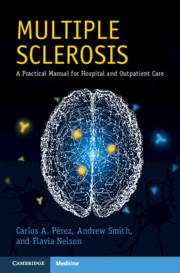Book contents
- Multiple Sclerosis
- Multiple Sclerosis
- Copyright page
- Contents
- Preface
- Chapter 1 Autoimmune CNS Emergencies
- Chapter 2 Clinical Features of Multiple Sclerosis
- Chapter 3 Multiple Sclerosis Phenotypes
- Chapter 4 Diagnostic Evaluation
- Chapter 5 Differential Diagnosis
- Chapter 6 Neuroimaging in Multiple Sclerosis and Its Mimics
- Chapter 7 Disease-Modifying Therapies
- Chapter 8 Treatment Goals
- Chapter 9 Symptomatic Management
- Chapter 10 Reproductive Issues
- Chapter 11 Pediatric Multiple Sclerosis
- Chapter 12 Useful Websites
- Appendices
- Index
- Plate Section (PDF Only)
- References
Chapter 9 - Symptomatic Management
Published online by Cambridge University Press: 10 February 2021
- Multiple Sclerosis
- Multiple Sclerosis
- Copyright page
- Contents
- Preface
- Chapter 1 Autoimmune CNS Emergencies
- Chapter 2 Clinical Features of Multiple Sclerosis
- Chapter 3 Multiple Sclerosis Phenotypes
- Chapter 4 Diagnostic Evaluation
- Chapter 5 Differential Diagnosis
- Chapter 6 Neuroimaging in Multiple Sclerosis and Its Mimics
- Chapter 7 Disease-Modifying Therapies
- Chapter 8 Treatment Goals
- Chapter 9 Symptomatic Management
- Chapter 10 Reproductive Issues
- Chapter 11 Pediatric Multiple Sclerosis
- Chapter 12 Useful Websites
- Appendices
- Index
- Plate Section (PDF Only)
- References
Summary
Symptoms of multiple sclerosis (MS) vary considerably from person to person and change over time. Most of these symptoms can be alleviated, but very few can be eliminated completely. Not all symptoms associated with MS are directly related to inflammation of the central nervous system. Although treatment of the disease itself is of major importance, treatment of secondary symptoms is equally important, as failure to do so can compromise quality of life for both patients and their families. In this chapter, we discuss the most common MS-related symptoms and their management. It is important to keep in mind that all treatments used have the potential for side effects. For some symptoms, nondrug approaches are the best initial approach to treatment. Potential difficulties associated with some forms of treatment are also discussed.
Information
- Type
- Chapter
- Information
- Multiple SclerosisA Practical Manual for Hospital and Outpatient Care, pp. 157 - 176Publisher: Cambridge University PressPrint publication year: 2021
